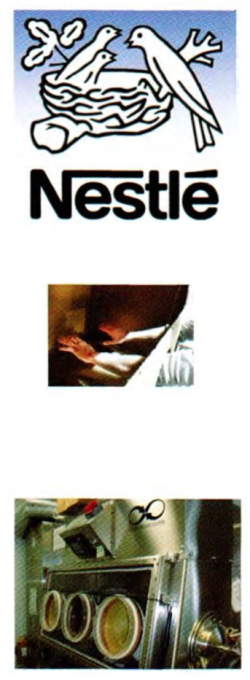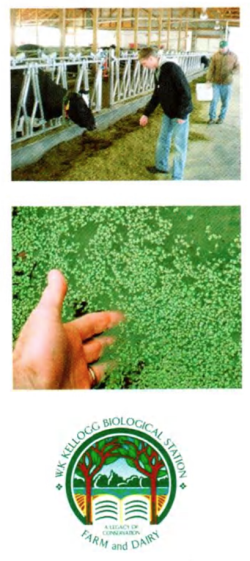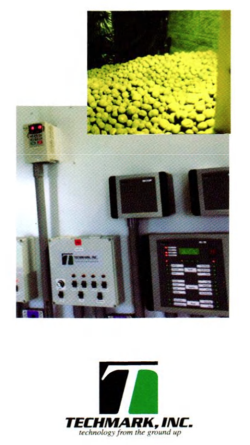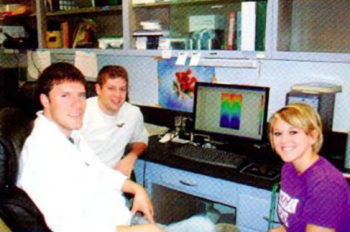Biosystems
Projects
Biosystems engineers integrate and apply principles of engineering and biology to a wide variety of socially important problems. The MSU biosystems engineering program prepares graduates to:
- Identify and solve problems at the interface of biology and engineering, using modern engineering techniques and the systems approach and
- Analyze, design, and control components, systems, and processes that involve critical biological components.MSU biosystems engineering graduates are having a positive impact on the world, working in areas such as ecosystems protection, food safety and biosecurity, biocnergy, and human health.
For information on sponsoring a project, please contact Dr. Dana Kirk or Dr. Luke Reese.
Pilot Bioengineering for Stabilization of the Red Cedar River
 The Red Cedar River, on Michigan State University’s campus, presents signs of riverbank erosion. Widening of the stream channel and bank undercutting has exposed infrastructure and damaged riparian habitat along the river corridor. The MSU-WATER initiative requested a sustainable stabilization plan that enhances biodiversity while being resistant and resilient to flood events, cost effective, and aesthetically appealing.
The Red Cedar River, on Michigan State University’s campus, presents signs of riverbank erosion. Widening of the stream channel and bank undercutting has exposed infrastructure and damaged riparian habitat along the river corridor. The MSU-WATER initiative requested a sustainable stabilization plan that enhances biodiversity while being resistant and resilient to flood events, cost effective, and aesthetically appealing.
In order to model the stability of the system, geomorphologic, geotechnical, and hydraulic analyses were performed. Tributary discharges and dimensions were compared, and the watershed was found to be in a state o f quasi-equilibrium. Site-specific hydraulic analyses were then performed using HEC- RAS to predict key design parameters of shear stress, velocity, and water surface elevation.
Vegetated cobble will provide a stable foundation at the toe of the slope, grasses and hardwood cuttings will reinforce the soil, and “terracing”with live branches will reduce sediment transport. The design providesa sustainable solution by combining mechanical stabilization with biological resilience.
Further recommendations to reestablish floodplain connectivity include the expansion of riparian buffer strips and reshaping of channel geomorphology.
Nestle Aseptic Filler
 The Nestle-Gerber pilot-plant requires an efficient sterile, or aseptic, process for filling a diverse array of products into varying sized and shaped packages for research and development testing. An aseptic filling environment needs to be designed, constructed, and validated for implementation in the pilot plant.
The Nestle-Gerber pilot-plant requires an efficient sterile, or aseptic, process for filling a diverse array of products into varying sized and shaped packages for research and development testing. An aseptic filling environment needs to be designed, constructed, and validated for implementation in the pilot plant.
This design includes four components: chambers, sterilization system, product filler, and controls. Three connected chambers are used to isolate and sterilize packages for filling. Next, sterilization is performed using vaporized hydrogen peroxide (VHP). The filler loads packages precisely with a predetermined volume. An electronic interface controls and monitors temperature, relative humidity, hydrogen peroxide concentration, air flow rates, and internal chamber pressure.
Theoretical results are simulated using computational fluid dynamics modeling software. With this model, a baseline VHP cycle time is established to optimize the sterilization process and assure sufficient surface contact. The goal is to prove a log four reduction of microbial pathogens. Economic analysis is used to optimize the design for long-term operations.
Statistical testing of the pathogen reduction inside the filling chamber will be completed on site. Standard operating procedures will be established to assist operators in using the aseptic filler properly. Documentation of the project is recorded to help Nestle operate and maintain the aseptic filling chamber.
Integrated and Anaerobic Digester and Treatment Wetlands for Pasture Based Dairy Farms
 The objective of this project is to utilize mathematical models to develop and optimize a preliminary engineering design that produces renewable energy while also biologically treating waste. This project focuses on the design of an anaerobic digester coupled with a treatment wetland for small dairies using the Kellogg Biological Station (KBS) as a case study.
The objective of this project is to utilize mathematical models to develop and optimize a preliminary engineering design that produces renewable energy while also biologically treating waste. This project focuses on the design of an anaerobic digester coupled with a treatment wetland for small dairies using the Kellogg Biological Station (KBS) as a case study.
Because KBS is a pasture based dairy farm, manure from its 100 lactating cows is only available in significant quantities during winter months, when the cows are housed inside. Results predict that sufficient manure is not available for the production of large amounts of gas for electricity or heat generation. However, by adding wetland plant material, such as duckweed grown in the treatment wetland, to the digester during the summer months, this project could be economically feasible.
Designing a comprehensive waste management system for any small farm requires a substantial capital investment. Additional and sometimes nontraditional methods will be needed to achieve sustainability.
Determining Restriction Potential & Engineering Alternatives for Carcinogenic Substances
 Under the growing concern for global health safety and environmental sustainability, various regulatory agencies, such as the U.S. Environmental Protection Agency (EPA) and European Chemicals Agency (ECHA), arc seeking to restrict the use of substances shown to be hazardous to humans and/or the environment. Inconsistencies in the restriction criteria exist between agencies and the lists are frequently updated as new information is found. Abbott Labs is seeking a standardized method of predicting restriction potential in order to determine whether the substances of concern used in their manufacturing of products or packaging are likely to become restricted and a procedure to evaluate alternatives.
Under the growing concern for global health safety and environmental sustainability, various regulatory agencies, such as the U.S. Environmental Protection Agency (EPA) and European Chemicals Agency (ECHA), arc seeking to restrict the use of substances shown to be hazardous to humans and/or the environment. Inconsistencies in the restriction criteria exist between agencies and the lists are frequently updated as new information is found. Abbott Labs is seeking a standardized method of predicting restriction potential in order to determine whether the substances of concern used in their manufacturing of products or packaging are likely to become restricted and a procedure to evaluate alternatives.
In order to accomplish this goal, a flow chart model was developed to determine restriction probability of carcinogenic compounds of concern to Abbott. By integrating toxicological research on currently restricted substances from the International Agency for Research on Cancer (IARC) and U.S. regulatory agencies, the model assesses restriction probability on a global and qualitative scale. Carcinogens of concern to Abbott, deemed to yield the highest restriction probability, were quantitatively assessed in order to recommend sustainable alternatives.
Abbott seeks to be proactive about assessing the increase in global restriction of hazardous chemicals. Thus, the developed prediction model will serve as a foundational method for addressing such regulatory concerns and provide the means to predict chemicals that may be restricted in the future.
Sustainable Urban Detroit Goat Farm
 With the plummeting population and increase of inexpensive unused land, urban agriculture has become a business opportunity within many cities including Detroit. Goat farming provides unique opportunities for the production of meat while providing employment and educational facilities in an urban environment. However, goat farming produces problems such as managing waste and creating a sustainable cash flow. Project objectives are to create a computer model that optimizes energy inputs with meat outputs, waste management, land availability, and employment. The project constraints require a minimum of forty goats to optimize meat production with useable land that contains both pasture and feeding space within a building.
With the plummeting population and increase of inexpensive unused land, urban agriculture has become a business opportunity within many cities including Detroit. Goat farming provides unique opportunities for the production of meat while providing employment and educational facilities in an urban environment. However, goat farming produces problems such as managing waste and creating a sustainable cash flow. Project objectives are to create a computer model that optimizes energy inputs with meat outputs, waste management, land availability, and employment. The project constraints require a minimum of forty goats to optimize meat production with useable land that contains both pasture and feeding space within a building.
The model includes multiple Excel routines to enable the optimization of a desired inputs. One optimization option matches the number of goats desired to housing and feeding needs, expected profit, and land area required. A second option requires the amount of land available to determine the herd size, feed requirements, and net profit. The third inputs a desired profit margin and outputs the number o f goats and land requirements.
Included in the model outputs are the amount of waste produced, number of goats, and the heating and space requirements. A plan to compost the waste into a desirable product (fertilizer) is also provided. To substantially reduce the odors, gas emissions from the compost will flow through a biofilter.
Results from the model found that over forty goats are required for an urban farm to be financially sustainable. Donations or grants are required to keep the business viable. However, the model contains many assumptions that should be further explored prior to construction of an urban goat farm.
Design for Improving Air Exchange in Potato Storage
 Potatoes are cooled and stored in bulk storage for 1 to 12 months after harvesting and before being processed into potato chips. Respiration occurs during storage; the sugar
Potatoes are cooled and stored in bulk storage for 1 to 12 months after harvesting and before being processed into potato chips. Respiration occurs during storage; the sugar
in the potatoes combines with oxygen in the air to produce carbon dioxide, water, and heat.
Glucose + Oxygen —» Carbon Dioxide + Water + Heat
Proper air exchange removes carbon dioxide and heat while retaining the potato moisture content, which provides a higher yield when sold. Techmark. Inc., advises farmers on ventilation techniques and is therefore, interested in how variable frequency drive fans impact potato quality and electrical consumption requirements. The objective of this project is to use an air, heat, and mass transfer computer model to design an improved fan setting strategy. Computational Fluid Dynamic modeling is used to show how pressure differentials through the potato pile relate to the air flow, which corresponds to the respiration of the crop.
The project design uses potato characteristics and air properties, such as temperature and humidity, to solve heat and mass transfer equations. Different fan speeds are simulated to determine the most efficient strategy. Use of this model leads to improved air exchange settings, which result in reduced energy costs and improved crop yields.





